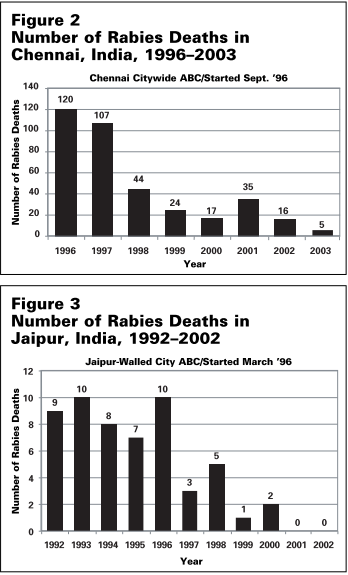Modeled after successful trap-neuter-release programs for managing feral cat populations in the United States, Capture-Neuter-Release (CNR) initiatives for feral dog mitigation has taken hold in several regions worldwide. The main concern regarding large wild dog populations is the risk it poses to human health. As mentioned in the “Before TNR” section, there is a significant correlation between feral dog numbers and rabies transmission rate. Several regions greatly affected by this issue have implemented CNR as an alternative to culling.
India
India has been a pioneer for CNR programs in controlling dog numbers, as it currently boasts a population of roughly 24 million dogs (Jackman & Rowan, 2007). Its populous cities like Jaipur, Chennai, and New Delhi previously had exceedingly large street dog colonies living in urban areas, and as a result had many rabies-related deaths in its human population. Its previous attempts at reducing the numbers through culling had been unsuccessful, spurring officials to seek an alternative.
Following guidelines set by the World Health Organization (WHO), the Indian government has begun to introduce CNR protocol to these regions, with majority public support (Jackman & Rowan, 2007). The initiatives aim to control, not eliminate, these populations by increasing the number of sterile, vaccinated dogs on the streets, without opening up territory for other intact dogs to occupy (Jackman & Rowan, 2007). The integration of these techniques have been met with overwhelmingly positive results, effectively eliminating rabies-related deaths in human populations in affected cities.

Rates of rabies-related human deaths in Indian cities decrease in subsequent years after introduction of CNR (Jackman & Rowan, 2007)
Island Nations
Street dogs run rampant in many island nations across the globe, with populations nearing up to 20% of that of the local human populations in certain countries (Jackman & Rowan, 2007). While the public often opposes the practice of sterilizing dogs for cultural or other reasons, introduction of CNR in these areas has been met with great success.
In Abago, by a program called Project Potcake (potcake meaning street dog), locals were initially incentivized to capture and bring in feral dogs to be sterilized for a $10 reward, although the incentive was later removed as the project gained favor with the public (Jackman & Rowan, 2007). Surveys revealed that 50-75% fewer dogs were seen on the streets in the year following the start of the program than in the year prior (Jackman & Rowan).
In Bali, an island nation with a dog population over 1/5th the size of the human population, an effort was made to reduce dog density by the Bali Street Dog Foundation in 1998. In years following, targeted villages saw reductions in street dogs by up to 50% if 75% of the dogs in the area were sterilized (Jackman & Rowan, 2007).
